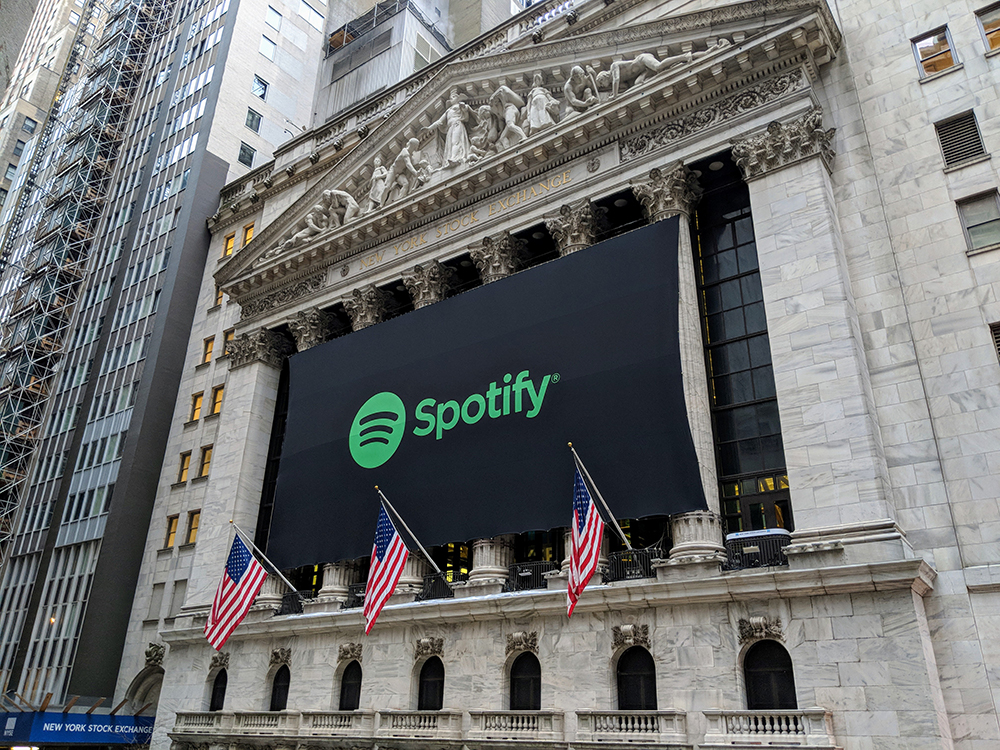
Leading the Race to a Billion Users
Do you remember the early days of online streaming music? It started with Napster, a peer-to-peer, file-sharing service that allowed music fans to upload their music to a database and download music that others had uploaded. And the site worked great until a series of lawsuits from the Recording Industry Association of America shut it down back in 2001.
Apple (AAPL) launched its iTunes Music Store in 2003 and that changed the map of music forever. Bye-bye CDs, hello streaming digital bits. Pandora entered the fray two years later, introducing the first music-selection service based on “taste algorithms.” Today, the big gorilla in the streaming-music-service room is Spotify (SPOT).
When Spotify launched in 2008, it had learned from its forerunners. It put together their best features into one package. Lossy (data compression) streaming audio, improved consumer internet connectivity, high-quality audio playback, adaptable bandwidth constraints, and more. Spotify also created the first machine-learning-driven music recommendation platform: the more you listened, the more Spotify’s recommendations adapted to your tastes. With Spotify, for the first time, a catalogue that even Napster couldn’t compete with was available for free.
Spotify dominates the music streaming market — there is no question about that. But it’s also growing like a weed. It has a massive expansion runway in the decades ahead, and multiple levers to improve margins – the biggest concern of this sector – over time.
Here’s why Spotify is one of my top stocks to buy right now for the weeks and months ahead.
Spotify dominates the subscription audio streaming business around the world. It ended September with 320 million monthly active users (MAUs), including 144 million paid premium subscribers (PPS). Prices range from $4.99 per month for students to $29.99 for a household of five. Both the free and paid subscriber figures grew 29% and 27%, respectively, from a year earlier. Since the free members are bombarded with ads – some of which are truly cringe-worthy – Spotify has seen a steady stream of free users who switch to premium.
The real story is ahead of us, though. There are, first, more than 3 billion payment-enabled smartphones in Spotify’s target market, and another 6.4 billion outside of China (where Spotify doesn’t compete) – places where global digital platforms like Facebook and Google have registered MAUs in the multiple 10-figures. Given that, it’s not hard to imagine Spotify eventually having a total MAU over 1 billion.
On the company’s third-quarter conference call last week, co-founder and CEO Daniel Ek said, “Even though we have 320 million monthly active users, we still think that there are billions more to go after in this ecosystem.”
In that same call, Ek gave a range of fourth-quarter growth that disappointed investors. His figure of 146-153 million paying subscribers by the end of 2020 would calculate to a fourth-quarter growth of 27% at the high end. This is excellent growth, of course, and matches what the company did in the third quarter, but it does not show the kind of acceleration to which investors had grown accustomed. On that news, the stock got slammed for several days (to be fair, the market itself was down sharply over the same period) before bottoming after a 20% haircut.
But here’s the thing: Spotify management is adept at under-promising and over-delivering. Most analysts say as much. They read the news as a conservative management of expectations and not a cause for concern. Rosenblatt Securities analyst Mark Zgutowicz, who earns an average of 47% on each of his “buy” calls, with a 78% win rate – reiterated his buy call on the stock and raised his price target to $325.
More good news: in a move that demonstrates confidence in growing demand, Spotify plans to raise prices in its more mature markets where it sees strong subscriber engagement. It just raised prices on its Family plan in seven international markets, and more selective price increases are to come.
Even more good news: podcasts are the principal driver of its ad revenue segment, and to this end Spotify is growing its supply of owned-and-exclusive (O&E) content. Last year alone, Spotify invested $400 million in this space. Last year, Spotify acquired Bill Simmons’ sports/pop culture website and podcast network, The Ringer. It also signed Joe Rogan’s mega-hit podcast The Joe Rogan Experience to a multiyear exclusive deal starting next month, and most recently it brought Michelle Obama’s podcast onboard, which launched at the end of July.
Not only do these high-profile shows drive new users to the platform, they also drive advertisers there. Spotify owns all the advertising rights on these O&E podcasts. As MAUs and O&E listeners continue to grow, advertising on the platform becomes attractive. In fact, the number of advertisers just doubled quarter on quarter!
The biggest concern with the music streaming business model, of course, is the margins. Not only are the infrastructure and tech costly to build and maintain, but all those royalty payments for the content drive margins way down. With that said, it should be noted that Spotify has several levers it can pull to improve the spread.
One such lever is Spotify’s ramp-up of sponsored recommendations – anyone who listens on a free subscription knows these all too well – wherein aspiring artists advertise their works for a fee to the subset of users that Spotify’s algorithm thinks will like them. CEO Ek has said that this segment has “software type” margins (Microsoft, for example, sports a profit margin of 32%). It makes sense: emerging-artist music, much of which is uncopyrighted, is cheap or even free, and the musicians pay Spotify to play it. Now that Spotify is inserting this promotional music into its personalized recommendations, there should be no shortage of material coming from this sector.
Here’s another one. Young, new artists want to grow, engage, and monetize their fan bases. Spotify wants to help them. It is now building tools that will enable artists to connect listeners not only to recorded music, but also live events, virtual events, even artist merchandise. As Spotify builds out these services – imagine Spotify as a kind of music-centric Amazon – it should be able to position itself as the indispensable platform for new musicians, much as CreateSpace is for new writers.
Action to Take: Consider buying SPOT for your growth-oriented portfolio at a price of $270 or under, with a view to selling once the stock hits $350.
SPONSORSHIP
4 Undervalued Stocks With Huge Growth Potential
We use a wide array of tools and metrics to analyze today’s top undervalued stocks, such as a favorable ratios, past performance, and competitive advantage. Within this report, you’ll find 4 stocks selling below intrinsic value with massive growth potential.
Get the Top 4 Undervalued Stocks
(By clicking you agree to receive email updates and special offers from Fxtrade)

















